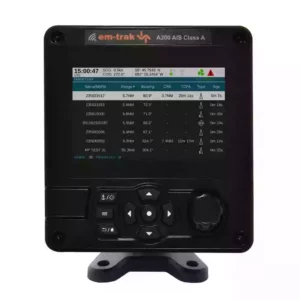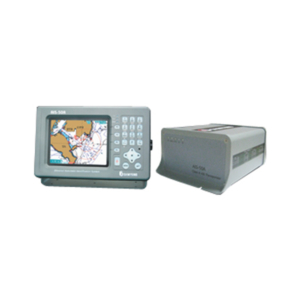Class A AIS Transponders and Class B AIS Transponders
AIS Transponders
An Automatic Identification System (AIS) transponder, also known as a transceiver, is a location and vessel information reporting system that makes use of Very High Frequency (VHF) digital transmissions. It is installed on boats and vessels to regularly share their location, position, course, and speed with other similarly equipped vessels.
In addition, the AIS system also employs Time Division Multiple Access (TDMA) receivers, a channel access method that divides time into slots to prevent interference and ensures efficient communication. Moreover, the data can also be used to avoid collisions and track other vessels, supported by standardised AIS communication protocols for message structures, error checking, and collision avoidance.
Looking for transponders? At Tecomart, we provide many different types of Class A and Class B AIS transponders from a range of brands, including em-trak, Samyung ENC, and ICOM.
Components of AIS Transponders
An AIS transponder integrates multiple components to provide updated and accurate information about the location of a vessel. A VHF transmitter broadcasts the position and course data of the vessel, while two VHF TDMA receivers gather this data from other vessels. A VHF DSC receiver is also included in the system, allowing it to receive distress signals and other safety-related messages. In addition, the system utilises a standard marine electronic communications link to connect with shipboard display and sensor systems. Timing information for an AIS transponder is typically derived from an external Global Positioning System (GPS) receiver.
Choosing An Appropriate AIS Transponder
When choosing an appropriate AIS transponder for your vessel, it is important to consider the features that will best meet your specific needs.
Types of AIS Transponders
AIS transponders are an invaluable tool for both professional and recreational shipping. Their applications can vary greatly, so it is important to select the right type of AIS transponder when choosing one. Professional vessels typically require high-precision tracking data, while recreational vessels may only require basic navigational information. There are mainly two types of AIS transponders available to fit the needs of each type of vessel.
Class A AIS transponders transmit at a higher VHF signal power and more frequently, allowing them to be received by more distant vessels. They are usually installed on large vessels, such as cargo ships and large passenger vessels, due to regulatory requirements.
Meanwhile, Class B AIS transponders transmit at a lower power and at a lower reporting rate than Class A transponders. They are also typically lower in cost.
Our catalogue of transceivers contains different models of Class A & Class B AIS transponders, including:
- A200 Class A AIS Transceiver IMO SOLAS: The A200 Class A AIS Transceiver IMO SOLAS is designed to be incredibly robust, with advanced components and materials built to withstand the toughest conditions. Its waterproof technology keeps it protected from corrosion, damage and water ingress, even in the harshest of marine environments. It also has a shock-absorbing body that safeguards against vibration and temperature fluctuations.
- Em-Trak B921: The Em-Trak B921 is a certified Class B AIS Transponder with a 2W CSTDMA power output. It is globally certified by USCG, FCC, Canada, and Europe. The transponder is equipped with an SRT-AIS™ transceiver engine for superior performance and a FLEXI-FIT™ bracket system for easy, secure, and convenient installation. The transponder also comes with an integrated high-performance GPS receiver and antenna (with an option for an external antenna). The device is waterproof, pressure-spray proof, and damp-proof (IPx6 & IPx7), and is ruggedized to protect against vibration, shock, and extreme temperatures.
- ICOM MA-510TR: The ICOM MA-510TR Class B AIS Transponder offers several benefits for boat owners and navigators. Its 4.3-inch colour TFT LCD screen provides clear visibility and the simplified navigation makes sailing easy, while the navigation to MOB waypoint ensures safe return of people overboard. Additionally, the individual DSC call, USB connectivity, and supplied GPS antenna make it easy to communicate and receive real-time information. The transponder also offers NMEA 2000, NMEA 0183/-HS connectivity and a collision alarm function to improve safety.
Antenna
It is recommended to get AIS transponders that include at least a GPS antenna to help provide location and navigation capabilities. Some AIS transponders, such as the EM-Trak B923 CLASS B AIS with Splitter also include an antenna splitter, allowing it to share an antenna with the VHF radio.
Compatibility with other equipment
Certain AIS transponders have special features that only work with other equipment from the same brand. For example, tracking features allow ships to save AIS targets of interest with a special icon and name.
Shop AIS Transponders at Tecomart Today
As a leading provider of wholesale marine communication equipment and marine navigation equipment, Tecomart has a longstanding reputation in the field of radio communication. With years of experience and specialisation in providing solutions for both professional and recreational maritime applications, we are the place to shop for Class A and Class B AIS transponders at wholesale prices. Our wide selection of products from leading brands ensures that you are getting the highest quality components and technology available. Furthermore, our commitment to excellence and our unwavering focus on customer satisfaction underscores our expertise and trustworthiness.
Besides our range of world-class AIS transponders, we also carry a wide range of other equipment, such as antenna rotator systems and Handheld Analog / Digital Mobile Radios. Feel free to contact us for more information or request a quote to get started.
Frequently Asked Questions About Class A & Class B AIS Transponders
Showing 1–15 of 44 results
-

A200 Class A AIS Transceiver IMO SOLAS
Request a quote for latest pricing
Request A Quote -

A200 Class A AIS Transceiver IMO SOLAS (GPS Bundle)
Request a quote for latest pricing
Request A Quote -

AIS-50A Class A AIS Transponder (China)
Request a quote for latest pricing
Request A Quote -

AIS-50N
Request a quote for latest pricing
Request A Quote -

AIS350 AIS Receiver (E32157)
Request a quote for latest pricing
Request A Quote -

AIS650 Class B Transceiver (E32158)
Request a quote for latest pricing
Request A Quote -

AIS700 Class B Transceiver (E70476)
Request a quote for latest pricing
Request A Quote -

em-trak B200 High Power Class B AIS (GPS Bundle)
Request a quote for latest pricing
Request A Quote -

em-trak B200 High Power Class B AIS Transceiver
Request a quote for latest pricing
Request A Quote -

Em-Trak B400 CLass B AIS (GPS Bundle)
Request a quote for latest pricing
Request A Quote -

Em-Trak B400 CLass B AIS Transponder
Request a quote for latest pricing
Request A Quote -

Em-Trak B921 Class B AIS Transponder
$780.00
Add to cart -

Em-Trak B921 Class B AIS Transponder (GPS100 Bundle)
$950.00
Add to cart -

Em-Trak B922 CLASS B AIS with WIFI and Bluetooth
Request a quote for latest pricing
Request A Quote -

Em-Trak B922 CLASS B AIS with WIFI and Bluetooth (GPS100 Bundle)
Request a quote for latest pricing
Request A Quote
